Giochi dell'Oca e di percorso
(by Luigi Ciompi & Adrian Seville)
(by Luigi Ciompi & Adrian Seville)

|
Giochi dell'Oca e di percorso
(by Luigi Ciompi & Adrian Seville) |

|
 |

Torna alla ricerca giochi (back to game search) |
 |
| New (A) Dioramic Game Overland Route to India | ||
 |
Versione stampabile
 |
Invia una segnalazione

|
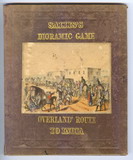 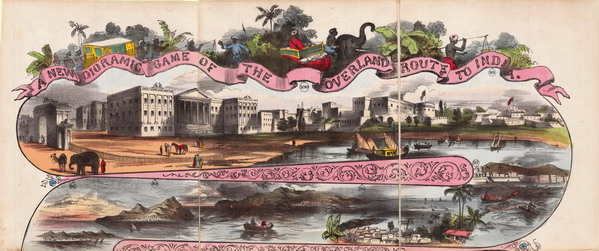 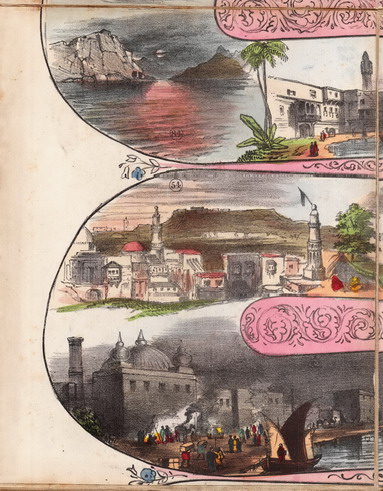 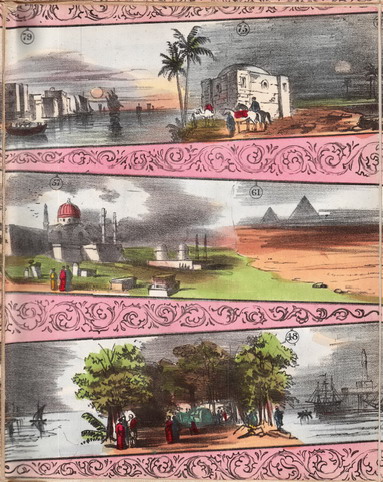 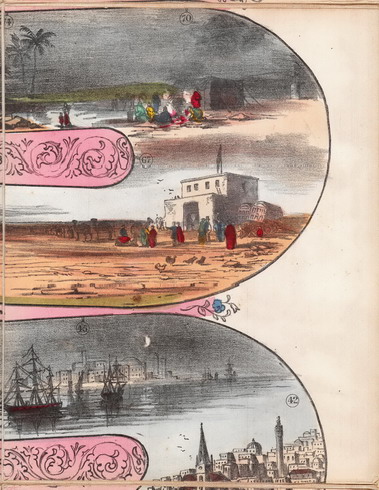 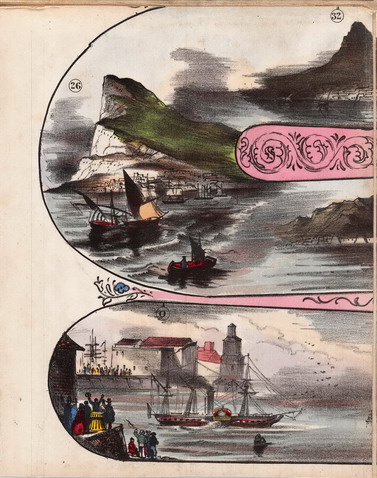 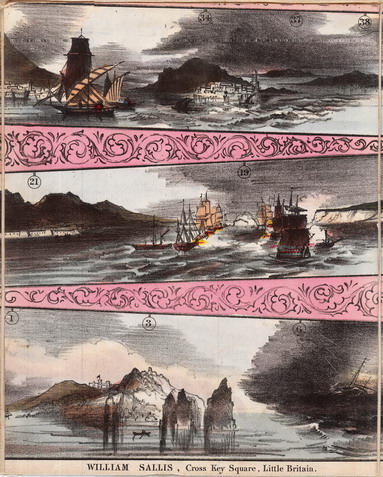 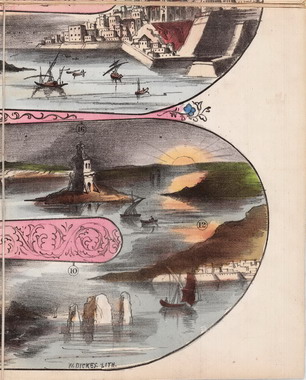 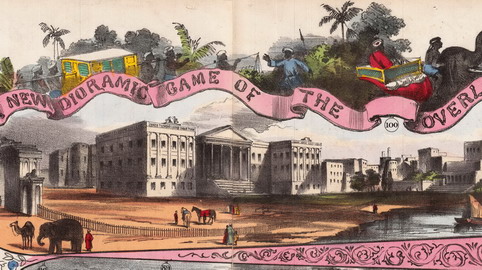 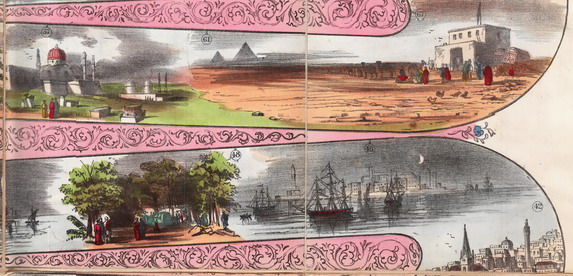 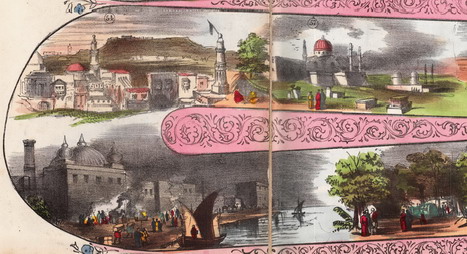 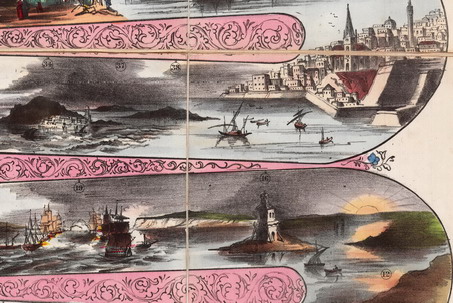 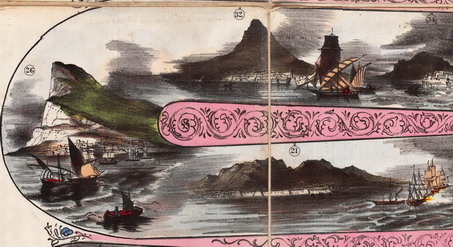 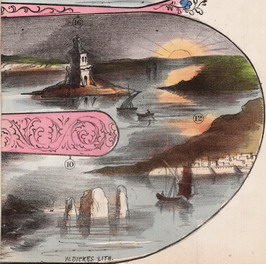 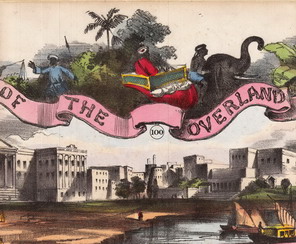 |
primo autore: | Non indicato |
| secondo autore: | Sallis William | |
| anno: | 1852/66 | |
| luogo: |
Inghilterra-Londra |
|
| periodo: | XIX secolo (3°/4) | |
| percorso: | Percorso a serpentina numerate | |
| materiale: | carta incollata su tela (engraving on paper with linen backing) | |
| dimensioni: | 615X495 | |
| stampa: | Litografia colorata a mano (hand-coloured engraving) | |
| luogo acquisto: | Italia-Pistoia | |
| data acquisto: | 30-07-2007 | |
| dimensioni confezione: | 210X170 | |
| numero caselle: | 100 | |
| categoria: | Geografia | |
| tipo di gioco: | Gioco di percorso | |
| editore: | William Sallis, Cross Key Square, Little Britain. | |
| stampatore: | Dickes W. Lith. | |
| proprietario: | Collezione L. Ciompi | |
| autore delle foto: | L. Ciompi | |
| numero di catalogo: | 582 | |
| descrizione: |
Gioco di percorso a serpentina (zig-zag) sul quale sono indicati alcuni numeri da 1 a 100. In alto: "A New Dioramic Game of the Overland Route to India"; in basso: "WILLIAM SALLIS-Cross Key Square, Little Britain". In basso a destra: "W. Dickes Lith." Manca il libretto (stampato da Francis Passmore) con le regole e la descrizione dettagliata del percorso. La partenza è da Southampton e l'arrivo a Calcutta. Il gioco composto da 9 pezzi è montato su tela e ripiegato all'interno di una copertina di cartone. Sulla copertina il titolo: "Sallis's Dioramic Game. Overland Route to India". REGOLE: non riportate sul tavoliere. CASELLE: mute. REFERENZA 1 "A New Dioramic Game of the Overland Route to India" (Victoria&Albert Museum). In order to play this race game each player is provided with a square piece of card, with the initial of their name, to mark his or her position on the route. There are 100 playing spaces beginning at Southampton Docks and continuing up the board to Calcutta. The game has no forfeits or rewards as such but each move is governed by the number determined from the spin of a teetotum. Players cannot move from place to place without the exact number being spun. The booklet has numbered and titled text blocks describing each of the ports of call. With each text is the direction for the next move and the number of the throw needed to reach the next destination. Physical description Design: coloured lithograph, playing sheet mounted on cardboard; the title is at the top; zig zag not spiral; with booklet printed by Francis Passmore. N°of squares: 100 moves Squares illustrated: background design Square numbering: 1 to 100 Squares titled: in booklet Subject of starting square: Southampton Docks Subject of ending square: Calcutta, India Place of Origin: London Date: 1852-1863 Artist/maker: William Sallis Materials and Techniques: Lithographed paper on card Dimensions: Length: 45.1 cm; width: 33 cm Object history note: The game has no forfeits or rewards as such but each move is governed by the number required from the spin. In the full length game, players may not move from place to place without the exact number being spun. William Sallis at address from 1852 to 1866. Historical context note Rewards: see Comments Forfeits: see Comments N°of Players: any Equipment required: teetotum Rules: DIRECTIONS FOR PLAYING THE GAME OF THE OVERLAND ROUTE TO INDIA This Game is to be played by a tee-to-tum, marked from one to eight. RULE I. Each player must be provided with a square piece of card, with the initial of their name, to mark his or her position on the route. RULE II. Each player will place their mark on the Southampton Docks, No. 0. RULE III. To commence the play, let one of the company spin the tee-to-tum, and should be Spin No. 1, he moves from Southampton Docks to the Isle of Wight, but on the other hand, should his number exceed that, he cannot move. Now let the next player spin, and if it be No. 1, he arrives at the Isle of Wight. It will be now necessary that in his next turn he should spin two; that added to the one brings him to the Needles. If he turn three the next time, he arrives at the Bay of Biscay, No. 6; but should he at any time spin either above or below the number required to gain the next place, he cannot move, as, in this game, he must get a sufficient number so as to visit each place on the route; as, i f he arrived at Fort William, by spinning one he immediately arrives at Calcutta, and wins the Game. NB. Should the Game be found too long, it may be shortened by observing the following: SUPPLEMENTARY RULE When a player spins, and the number is above that required to reach the next place on the route, he may remove to the next number, but if below, he must remain in his present position, as directed in Rule III. The booklet then has numbered and titled text blocks describing each of the ports of call from Southampton Docks to Calcutta. With each text is the direction for the next move, the number of the throw needed to gain the next destination.Rules placement: booklet of 12 pages, Printed by Francis Passmore, Printer, 45 Borough Road, Southwark (London)Descriptive line: Geographical game, Overland Route to India, published by William Sallis between 1852 and 1863 Attribution Note: Booklet printed by Francis Passmore. REFERENZA 2 WHITEHOUSE, Francis Reginald Beaman, (pag. 43): OVERLAND ROUTE TO INDIA (New Dioramic Game of). William Sallis, Cross Key Square, Little Britain. W. DICKES Litho. A coloured lithograph size 19 ½ in X 24 in, mounted in 9 sections on linen and folded into cloth-covered boards, with picture label on front; title in black. The game is a race: No 1 shows an early steamship leaving port, different countries are traversed until 100 is reached-a view of India. REFERENZA 3 A New Dioramic Game of the Overland Route to India - Neues Dioramaspiel: Der Landweg nach Indian London, 1852-1863 Lithografie, handkoloriert, 62X49 cm Verlag: William Sallis Sammlung: Victoria and Albert Museum, London (Inv-Nr.: SP. 534:1) Die Kenntnis ueber die sicheren Wege in die Kolonien war essenziell fuer das britische Empire: Sie versprachen exotische Begegnungen, mitunter Abenteuer und am Ende vor allem Reichtum. So sind viele englische Spiele im 19. Jahrhundert diesem erfolgversprechenden Thema gewidmet. Ahnlich wie L’Orient von David Ogilvy (Spiel 22), Tour Through the British Colonies von John Betts (Spiel 23) oder Elephant and Castle des direkten Konkurrenten William Darton (Spiel 24) weist auch Overland Route to India von William Sallis (1782-1865) den Weg nach Osten. Das Reisespiel des Londoner Spieleverlegers und Landkartenherstellers fuehrt vom Hafen in Southampton, wo die Reisenden verabschiedet werden, ueber Gibraltar, Malta, Kairo, Suez, Jeddah, Aden und Ceylon bis ans Ziel nach Kalkutta mit seinen reichen Palaesten und monumentalen Kolonialbauten. Der Plan besteht aus neun auf Tuch kaschierten Teilen, die aehnlich wie eine Landkarte gefaltet und auf ein handliches Buchformat gebracht werden koennen. Die Kommentare in der beigefuegten Broschuere wirken im Vergleich zu anderen Reisespielen der Zeit ausgesprochen nuechtern, das Spiel ist dennoch in mehrfacher Hinsicht bemerkenswert: Der Weg der Spieler fuehrt nicht ueber eine Spirale, sondern ueber Serpentinen mit sieben Kehren von unten nach oben, eine selten angewandte Form bei Laufspielen. Der Weg fuehrt auch nicht ueber Land, wie es der Titel verspricht, sondern hauptsaechlich ueber das Meer. Statt 100 Feldern, wie die Nummern am Spielplan vermuten lassen, sind es in Wahrheit nur 34 Stationen vom Ausgangspunkt bis zum Ziel, dies deshalb, weil man, den Regeln gemaess, von Feld zu Feld nur mit einer bestimmten Augenzahl weiterkommt. Die Reise geht nur aeusserst stockend weiter. Bei sechs Spielern waeren durchschnittlich etwa 1000 Wuerfe pro Spiel zu absolvieren. Dessen schien sich auch der Autor bewusst und hat dem Regelwerk voller innerer Hemmungen gluecklicherweise eine "zusaetzliche Regel" beigefuegt, die die Fahrt bis Kalkutta wesentlich bequemer gestaltet. Spielregeln Das Spiel wird mit einem Kreisel gespielt, der von 1 bis 8 markiert ist (Anm.: Der Kreisel kann leicht durch Karten von 1 bis 8 erserzt werden, die gezogen werden). 1. Jeder Spieler muss mit einer Karte mit den lnitialen des Namens oder einer Spielfigur ausgestattet sein, um seine oder ihre Position auf der Route zu markieren. 2. Das Spiel beginnt an den Southampton Docks (Feld 0). 3. Erzielt der Spieler eine 1, bewegt er sich von den Southampton Docks zur Isle of Wight (Feld 1), falls er eine andere Zahl wuerfelt, muss er warten. Nun kommt der naechste Spieler an die Reihe, auch er benoetigt eine 1. Beim zweiten Zug bringt ihn nur eine 2 von Feld 1 nach Needles (Feld 3). Wenn er beim naechsten Mal 3 hat, trifft er im Golf von Biskaya (6) ein. Er benoetigt also zur Weiterfahrt jeweils die exakt geforderte Zahl, um auf den naechsten Ort auf der Route zu kommen; wie zum Beispiel eine 1, wenn er von Fort William (99) ins Ziel nach Kalkutta (Feld 100) kommen Will. Wer Kalkutta als Erster erreicht, gewinnt das Spiel. Anmerkung: Sollte das Spiel als zu lang empfunden werden, kann es durch folgende zusaetzliche Regel verkuerzt werden. Der Spieler muss nicht die exakt vorgeschriebene Zahl erreichen, sondern darf zum naechsten Ort der Route auch weiterfahren, wenn die Zahl gruesser ist als die erforderliche. Ist sie kleiner, muss er warten. Felder 0 Southampton Docks. - Mit 1 weiter. 1 Isle of Wight. - Mit 2 weiter. 3 Needles. - Mit 3 weiter. 6 Golf von Biskaya. - Mit 4 weiter. 10 Burlings (an der portugiesischen Kueste), - Mit 2 weiter. 12 Cintra. - Mit 4 weiter. 16 Schloss Belem. - Mit 3 weiter. 19 Kap Trafalgar, - Mit 2 weiter. 21 Tariffa, - Mit 5 weiter. 26 Der Fels von Gibraltar. - Mit 6 weiter, 32 Algier. - Mit 2 weiter. 34 Pantalaria. - Mit 3 weiter. 37 Goletta. - Mit 1 weiter. 38 Gozzo. - Mit 4 weiter. 42 Malta. - Mit 3 weiter, 45 Alexandria, Mit 3 weiter. 48 Der Mahmoudie-Kanal. - Mit 4 weiter. 52 Boulac. - Mit 2 weiter. 54 Kairo. - Mit 7 weiter. 61 Die Pyramiden von Aegypten. - Mit 6 weiter, 67 Die zentrale Station in der Grossen Wueste von Suez. - Mit 3 weiter. 70 Das Zelt des Arabers. - Mit 4 weiter. 74 Jakobs Brunnen. - Mit 1 weiter. 75 Das Haus der Wachen. - Mit 4 weiter. 79 Suez. - Mit 5 weiter, 84 Das Rote Meer. - Mit 2 weiter. 86 Jeddah. - Mit 3 weiter. 89 Mocha. - Mit 2 weiter. 91 Aden. - Mit 4 weiter. 95 Ceylon. - Mit 2 weiter. 97 Madras. - Mit 2 weiter 99 Fort William, - Mit 1 weiter. 100 Kalkutta. (Ernst Strouhal) Exhibitions - “The Cottage of Content : or, Toys, Games, and Amusements of Nineteenth Century England". Yale Center for British Art, November 2 - December 31, 1977. |
|
| bibliografia: |
1) WHITEHAUSE, F.R.B.: "Table Games of Georgian and Victorian Days", London, Peter Garnett, 1951. 2) GOODFELLOW, Caroline: "A Collector's Guide to Games and Puzzles". Secaucus, New Jersey, Chartwell Books-London, Quintet Publishing Limited 1991. 3) GOODFELLOW, Caroline: "The Development of the English Board Game, 1770-1850", in Board Games Studies 1, 1998. 4) GOODFELLOW, Caroline: "Jeux de société. Le guide du collectionneur des jeux de société depuis le XVIIIe siècle jusqu’à nos jours", (Edizione francese) Carrousel MS, 2001. 5) SEVILLE, Adrian: "The Game of Goose: and its influence on cartographical race games" Journal of the International Map Collectors' Society, Winter 2008 N°115 2008. 6) SEVILLE, Adrian: "The geographical Jeux de l'Oie of Europe." In "Belgeo" 2008 3-4 2008. 7) GOODFELLOW, Caroline: "How We Played: Games From Childhood Past", History Press, 2012. 8) QUINN, Brian - CARTWRIGHT, William: "Geographic Board Games". Geospatial Science Research 3. School of Mathematical and Geospatial Science, RMIT University, Australia. December 2014. 9) SEVILLE, Adrian: "The Royal Game of the Goose four hundred years of printed Board Games". Catalogue of an Exhibition at the Grolier Club, February 23 - May 14, 2016. 10) LIMAN, Ellen: "Georgian and Victorian Board Games: The Liman Collection", Pointed Leaf Press, 2017. 11) NORCIA, Megan A.: "Gaming Empire in Children's British Board Games, 1836-1860". Studies in Childhood, 1700 to the Present. Routledge, 2019. |
|
| "The Development of the English Board Game, 1770-1850" (Caroline G. Goodfellow) | ||
| Instructional Games. "Table Games of Georgian and Victorian Days". (Francis Reginald Beaman, Whitehause) | ||
Vai alla ricerca giochi Vai all'elenco autori